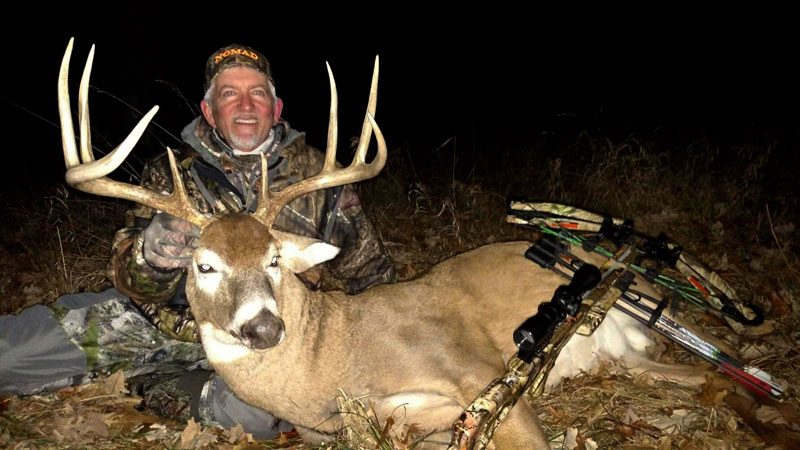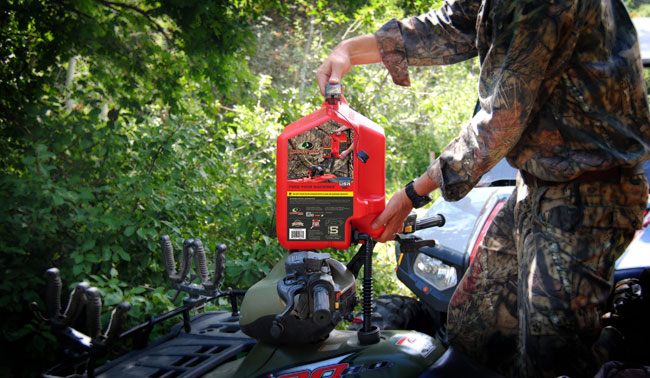Terry Drury | Drury Outdoors

The second post-rut buck I took in 2017 was on my farm in Missouri. My son Matt Drury had seen this buck during firearm season, and my grandson Carter had an encounter with this same buck. But neither Matt nor Carter got the opportunity to take a shot at the buck.
We had named this buck the “Big Sissy,” because he always fed just on the edge of the field. He never would walk out into the field where another buck might be. Even though I had never seen this buck in person, I could tell he was a sissy, because of the video footage we got of this deer. I could tell by his body posture that he wasn’t looking for, nor would he participate in, a buck fight. He didn’t have a very aggressive personality.
I'm almost certain this buck was a 4-1/2-year-old buck. I first began to notice him in 2016 when he was a 3-1/2-year-old buck. This hunt was on December 7, 2017, five days after I had harvested the buck in Illinois. Typically, the rut in Missouri is somewhere between November 10 and November 17.
I'm almost certain the reason this buck came out and presented the shot is because we were hunting with cold temperatures and a full moon. We had a north-by-northwest wind, a bluebird day and a rising barometer about 30.28. All the conditions were right for bucks to be on the green fields.
Once again, here are some important ingredients for taking post-rut bucks:
- falling temperature
- a full moon
- little or no hunting pressure on the area where you're going to hunt
- a good food source
I took the buck on a Mossy Oak BioLogic field I had planted. In my BioLogic field, I had Maximum, Winter Bulbs and Sugar Beets and DEER Radish. I like to mix several different types of Mossy Oak BioLogic products in my fields. Then the deer have a variety of food on which they can feed.
The buck was coming from the BioLogic field into a standing cornfield I had planted. The standing corn was about 10 to 12-feet high, and it provided security cover for the buck. The BioLogic was only about one-foot high and provided food for the buck. I liked the height difference between standing corn and the BioLogic field. The deer had plenty of highly nutritious food to feed on in the BioLogic field, and the standing corn provided cover and food.
I believe that by designing your green fields where you have two food sources - one that can provide food and cover, and the other food source that provides a variety of foods that the deer can eat. You can drastically increase the number of deer you can see after the rut if your hunting area has falling temperatures and a full or partially full moon.
I also created a rub tree and put it out in front of my box blind. I cut down a shingle oak, used a posthole digger to dig a hole to put the trunk of that tree in and set it within easy range of the box blind. Mark and I both like to create inside and outside corners. The inside corner is where the BioLogic field and the cornfield meet. The outside corners are where the BioLogic field meets the woods, and the cornfield meets the woods.
We saw tremendous deer movement that afternoon. We had 35 deer on the BioLogic field at one time. The Big Sissy was the fourth buck on the field that was on our hit list to harvest this season. We observed that the deer would come out and feed on the Mossy Oak BioLogic. Then they would walk into the standing corn.
I tried to take an 11-pointer that would score 150 to 160 inches, before I took the Big Sissy, but I couldn’t get the window on my box blind open quickly enough before the 11-pointer vanished into the standing corn.
After the Big Sissy had fed in the BioLogic field for about10 minutes, he walked right in front of the blind at 30 yards and headed into the standing corn. I grunted to him, stopped him and took the shot with a PSE Fang crossbow. I've never been known to shoot a crossbow, but not because I don’t like them. I just prefer to shoot a compound bow. However, I've always liked shooting their compound bows.
I shot that crossbow for six hours before I hunted with it. I tried different lengths of bolts and various types of helical fletchings. I probably shot 12 different bolts to try and choose the bolt that would give me the tightest group. All of the bolts I tested shot extremely well when I was shooting field tips. But when I screwed a Rage practice tip into the ends of the bolts, I could tell a huge difference in the way the bolts flew. The bolts that shot the best were the ones that had a slight helical to the fletchings.
When I ranged the Big Sissy buck with my Leupold range finder, I determined he was at 30 yards. I squeezed the trigger, and the broadhead hit a little high and forward of where I was aiming. I can’t blame the bolt, the broadhead or the crossbow. I just didn’t make as accurate a shot as I would have made if my ribs hadn’t been hurting. When I realized I’d hit the deer high, I was extremely concerned, because we have an old saying when deer hunting: “Hit ‘em high, and wave goodbye.” When the buck ran off, his tail was up instead of down, like it would be when I've made a good hit.
After we reviewed the footage that my cameraman had been taking, I saw that the bolt in the broadhead had penetrated about 12 or 14 inches into the deer. I couldn’t believe that that Fang crossbow had delivered that much penetration. I knew that buck was double-lunged then, and I actually thought I had heard the buck fall. Once I saw where I had hit the buck, I thought he was gone forever. But then when I looked at the video footage, I knew I had a good hit. That is one of the reasons that I strongly believe in videoing your hunt, because you can see where you’ve hit the deer immediately after the shot. When I saw that I had a good hit, we immediately went to track the buck. The buck had only gone about 65 yards from where he had taken the arrow.






























